Effect of Social Media on Teens: Influence & Consequences
Syed. Najma Sultana |
Child Learning |
2025-02-15 |
null mins read

Table of Contents
- How Social Media Affects You: Impact on Children & Harmful Effects
- What is Social Media?
- Positive Influence of Social Media on Adolescents
- Social Media Impact on Teen Behavior
- Social media contributes to the Communication Ability of Youth
- UPITT: Social Media From a Mental Health Perspective
- Optimizing Comprehensive and Focused Health Messages on Social Media Platforms
- How Can Social Media Be Both a Help and a Harm?
- Avoiding the Negative Effects of Social Media
- Empowering Parents: A Guide to Digital Awareness and Online Safety
- 10 healthy social media habits for young people
- A Guide to Social Media Use and how Parents Can Help
Excessive social media use is linked to anxiety, depression, low self-esteem, and sleep disorders. Driven by FOMO and social norms, teens spend hours online, exposing themselves to cyberbullying and unrealistic beauty standards. Overuse also leads to stress, attention issues, and social isolation. Encouraging balanced usage can help protect their mental well-being.
How Social Media Affects You: Impact on Children & Harmful Effects
Discover how social media can affect you, including its harmful effects and impact on children. Learn about the risks, benefits, and ways to use social media wisely.
What is Social Media?
Social media is a group of internet based applications that allow people to create and exchange information (content) and communicate with one another. These platforms revolutionized the communication paradigm - returning instantaneous exchanges across the world.
Key Aspects of Social Media:
-
Definition: Social media are applications based on the Internet that enable users to create and exchange user-generated content. Sample social media include Facebook, Instagram, TikTok, Snapchat, etc.
-
Key Features:
-
Contact: Enables chat and interaction in real-time.
-
Explanation: Users post experiences, stories, opinions, pictures, and videos.
-
Self-Presentation: Allows people to showcase themselves and their profiles for finding friends and connections.
|
Characteristic |
Description |
|
Real-Time Communication |
Allows real-time messaging and users updates over the globe. |
|
User-Generated Content |
Users, instead of traditional media outlets, create content. |
|
Networking Opportunities |
Enables users to interact with friends, family, and strangers. |
The influence of social media on young people has expanded dramatically over the last few years:
-
Near universal, with nearly 95% of young people aged 13-17 on at least one form of social media and many of them online 24 hours a day, 7 days a week.
-
Their latest research indicated that, in comparison with their parents, social media has changed the way young people communicate, learn, and interact with one another and themselves.
Advantages of Social Media
-
Building Relationships: Social media is convenient to use in a bid to maintain current friends & build new ones.
-
Creativity: It is an extremely creative platform where you are free to be yourself.
-
Social Awareness: Promotes greater social awareness & civic engagement.
Potential Risks
Social media has many benefits, but it also has humongous threats:
-
Cyberbullying: Internet bullying can lead to extreme emotional damage in teenagers.
-
Mental Health Problems: Studies recognize a correlation between overuse of social media and increased symptoms of depression and anxiety.
-
Unhealthy Comparisons: Comparison with unrealistically idealized pictures is unhealthy to self-esteem and body image.
|
Risk Factor |
Impact on Youth |
|
Cyberbullying |
Leads to anxiety, depression, and in extreme cases, suicidal thoughts. |
|
Mental Health Issues |
Increased rates of anxiety and depression linked to excessive use. |
|
Unrealistic Comparisons |
Can result in poor body image and low self-esteem among adolescents. |
Positive Influence of Social Media on Adolescents
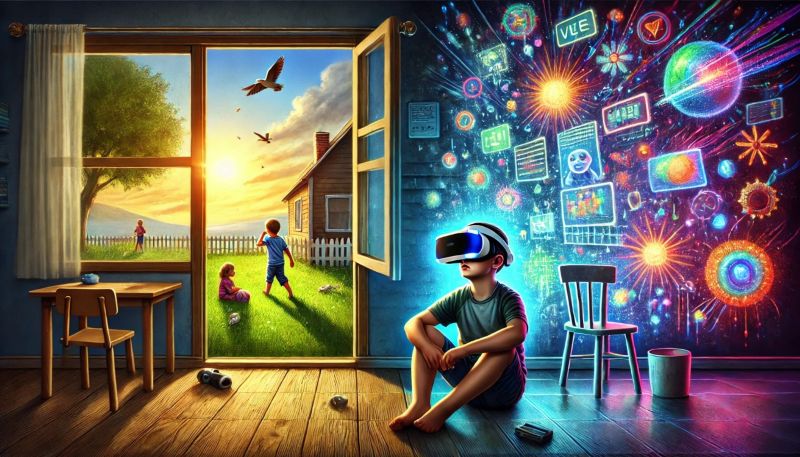
(Social media connects us but distances us from reality.)
How Social Media Assist in Education
Social media can make a very good learning platform for kids. It supports cooperative learning. It gives access to resources and debates. Plus, it exposes students to different viewpoints on many issues.
- Recent research highlights teens on social media ASL developing new communication strategies.
-
Educators are intrigued by the evolving teens on social media speech patterns shaping digital dialogue.
-
There’s growing interest in how ASL on teens on social media enhance visual communication.
-
Modern educators promote the idea of teens utilizing social media for creative learning opportunities.
-
The phenomenon of speech on teens on social media provides insights into their unique digital narratives.
Expanded Social Interaction:
- Students can use Facebook groups and specialized forums. This lets them connect with peers and instructors outside the classroom.
-
Another notable trend is the emergence of teens on social media ASL engaging in group discussions beyond the classroom walls.
-
The rise of teens on social media speech has redefined how students communicate and collaborate online.
-
Educators observe that ASL on teens on social media sessions foster inclusivity and a sense of community.
-
Studies show that teens utilising social media are more engaged in collaborative projects and creative exchanges.
- Emerging discussions reflect the evolving speech on teens on social media that enriches academic debates.
Learning Opportunities Outside of School:
- Social media offers many learning opportunities. You won't find most of these in traditional schools.
- Online platforms now offer courses where teens on social media ASL share practical insights and innovative ideas.
- Interactive webinars often feature teens on social media speech that inspires critical thinking.
- Workshops focusing on ASL on teens on social media have become popular, breaking barriers in communication.
- Countless resources empower teens utilising social media to learn new skills beyond the classroom.
- Expert panels discussing speech on teens on social media provide guidance on effective digital communication.
- More Access to Knowledge: Learners can look at a range of learning materials that are not accessible via traditional methods.
Social Media and Youth Awareness
Social media plays a big role in creating awareness among youth on significant social issues. It's a site for activists and advocates. Young people connect with causes like climate change and social justice.
-
Activism online is enriched by teens on social media ASL who share their personal experiences and insights.
-
Campaigns often feature authentic teens on social media speech to voice pressing social concerns.
-
Advocacy groups now use ASL on teens on social media to ensure their messages are accessible to all.
-
Numerous initiatives are driven by teens utilising social media to support and amplify local causes.
-
Social campaigns frequently rely on powerful speech on teens on social media to mobilize youth action.
Negative Social Media Impact on Teenagers
Social media has many benefits, but it can also harm teenagers' mental and emotional health.
Psychological Effects:
- Social media often leads to unrealistic comparisons. This can cause stress, depression, and feelings of worthlessness.
-
Some cyberbullying incidents specifically target teens on social media asl communities, intensifying these feelings.
Increased Vulnerability:
- Teenagers spending excessive time online are at a higher risk of developing mental disorders such as anxiety and depression.
-
At times, misinterpretations of teens on social media speech can lead to further isolation and misunderstanding.
Cyberbullying:
- The prevalence of online harassment can significantly affect teens’ self-esteem and overall well-being.
-
Negative content directed at groups using ASL on teens on social media can worsen their emotional stress.
Addiction and Sleep Deprivation:
-
Excessive engagement often leads to addiction, disrupting sleep cycles and affecting academic performance.
-
Concerns arise when teens utilizing social media face constant notifications that disrupt healthy routines.
-
Critics argue that distorted speech on teens on social media sometimes perpetuates harmful stereotypes.
-
Sleep Deprivation: This kind of addiction results in sleep deprivation, which has an association with the rising incidence of depression, anxiety, and even suicide in teenagers. It can also further add to mental disorders.
-
Academic Performance: Moreover, social media addiction may further hinder academic performance and break natural social relationships in real life. The more engrossed they are in the virtual life, the less focused they may get on studies and actual-life relations, which ends up isolating them and adversely affecting mental well-being.
-
Need for Awareness: The U.S. Surgeon General advisory urges awareness and protective measures to stop these dangers entailed by using social media in young generations.
Social Media Impact on Teen Behavior
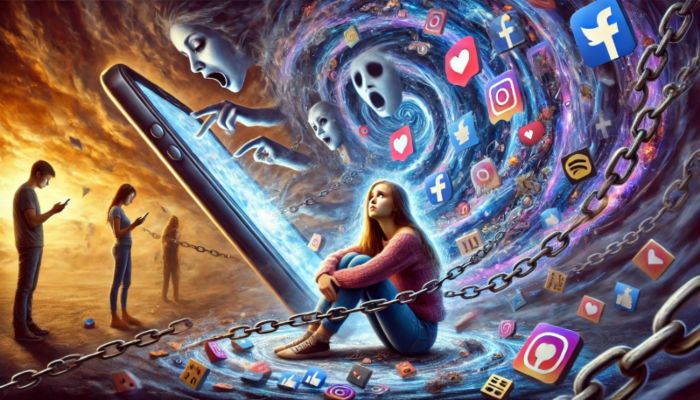
(Trapped in a digital world, losing touch with reality.)
- Devil May Care & Self-Esteem: Teens through social media seek satisfaction through likes and shares, prioritising their online identity over their real life relationships.
- Getting away from Responsibilities: Social media can create bad habits in unbalance manner such as skipping Study or Physical Exercises, etc.
- Trends And Opinions: Exposure to these trends and opinions may affect the decision-making process of teens and thus they may choose to follow the popular opinion of social media instead of what they believe in.
- Peer Pressure & Risque Behavior :The causes of social media peer pressure type things, eg pressure on the adolescent to use illegal substances or share things they want to keep private.
- Fear of Missing Out (FOMO): Teens are especially prone to doing something they wouldn’t normally do, just to feel included or relevant in their social groups.
Social media contributes to the Communication Ability of Youth
Social media links young people in many ways. They share text, images, and videos. This helps boost creativity and encourages inclusivity.
- Diverse Communication Alternatives:
- Platforms offer multiple communication tools that support both verbal and non-verbal expression.
-
Recent studies have observed that teens on social media asl use innovative sign language methods to express themselves.
-
The distinct tone in teens on social media speech reflects the creative identity of young users.
- New Relationships:
- Youth can forge new friendships and professional networks online.
-
Digital platforms now celebrate asl on teens on social media as a vital form of inclusive expression.
-
Observations reveal that teens utilising social media excel in digital networking, forming diverse communities.
-
The distinct speech on teens on social media represents a shift toward more expressive and individualized communication.
- Providing Support for Marginalized Groups: Social media is a space for marginalized groups to find the support and validation that might be lacking in their immediate environment.
- More Connected: It allows youth to connect with friends, family, and peers despite distance.
- Individuality: There, teens can be themselves and try on various personas in a safe, creative space.
It goes without saying that social media exerts a significant impact on a generation of young people, how they interact, their behavior and their beliefs. While it can be helpful, it also has its dangers such as tech addiction, sleep deprivation and increased stress. Adolescents tend to use social media for social norms, fear of missing out and social validation, according to the U.S. surgeon general’s 2023 advisory. Anti-social aspect of negative face of social media:
- Health & WellBeing: Anxiety and depression, low self-esteem and body image issues from comparing themselves to others.
- Social Interaction : Lapse of real life relations, alienation due to high involved usage.
- Decision Making: Surrendering to peer and social media pressure by choosing what is in vogue instead of what they value.
- Childhood behaviour: Acting on impulsive actions viewing from an online aspect, more concern on social medial than study and health.
These platforms cause emotional distress due to cyberbullying, while excessive usage has been shown to disturb sleep cycles, reduce attentiveness, and create social isolation. A study found that adolescents who spend more than three hours a day on social media are at higher risk for mental health problems, as well as sleep disturbances, so encouraging balanced use is imperative.
UPITT: Social Media From a Mental Health Perspective
Cyberbullying and Harassment
Cyberbullying is a looming threat to teens as well. Unlike bullying, cyberbullying can be relentless and more invasive because it exploits the anonymity the internet offers, he said. Victims suffer from severe emotional trauma that results in depression, anxiety, and occasionally suicidal tendencies. Teenagers bullied online are more likely to report feelings of hopelessness and self-harming behaviors, according to a study. There is a need for safe protection of juvenile users against the dangers of unsafe social media encounters, which requires interventions.
-
Cyberbullying poses significant risks, often causing emotional trauma among vulnerable teens.
-
Findings indicate that teens on social media ASL are particularly vulnerable to the adverse effects of online harassment.
-
A study noted that the clarity of teens on social media speech sometimes helps mitigate misunderstandings, though misinterpretations still occur.
Privacy Problems and Data Misuse
Again, teenagers are unaware of the privacy risks of using social media. Others alter it for identity theft, harassment, stalking - whatever, if they are the subject. The majority of data collected by social media brands is also having issues with the information and distribution of information without the consent of the minors. Most sites have been widely criticized for poor privacy safeguards and as such, parents and guardians must teach kids to protect their information.
- Parents are urged to monitor platforms where asl on teens on social media is widely used to ensure safety.
-
Concerns arise when teens utilising social media share personal data without proper guidance.
-
Critics highlight that distorted speech on teens on social media can fuel the spread of fake news.
Fake News and Misinformation
Young net citizens are also exposed to the spread of hoaxes and misinformation over the internet, another pernicious threat. Given that adolescents are not up to the task of sifting through actual and fake sources and developing knowledge, beliefs and attitudes based on that. This would set up their mental framework on important matters like health, politics and social justice. Research has found that misinformation has been shown to heighten fear and anxiety in adolescents, especially during a crisis or outbreak of an epidemic.
|
Danger |
Description |
Potential Consequences |
|
Cyberbullying |
Online harassment that occurs through social media platforms |
Anxiety, depression, suicidal thoughts |
|
Privacy Concerns |
Risks associated with sharing personal information online |
Identity theft, exploitation, harassment |
|
Fake News & Misinformation |
Spread of false information that can mislead young users |
Misinformed beliefs, increased anxiety |
Optimizing Comprehensive and Focused Health Messages on Social Media Platforms
The Relationship Between Social Media and Anxiety
Studies have shown that highly social media addicted individuals tend to be more anxious than those who control their social media use." The perils of social media, where we are constantly comparing ourselves with others curated lives, can result in low self-esteem and social anxiety. Researchers recently found that people who spend more than three hours a day on social media are twice as likely to report anxiety symptoms as those who aren’t as frequent users.
Depression and Social Media Usage
This same pattern is reflected in the association between social media use and depression. Young adults who are often exposed to negative interactions and unrealistic narrations of life might show augmenting depressive symptoms. The statistics surrounding the impact of high social media usage on mental health is alarming with 41% of teens rating their mental health with a poor or very poor score.
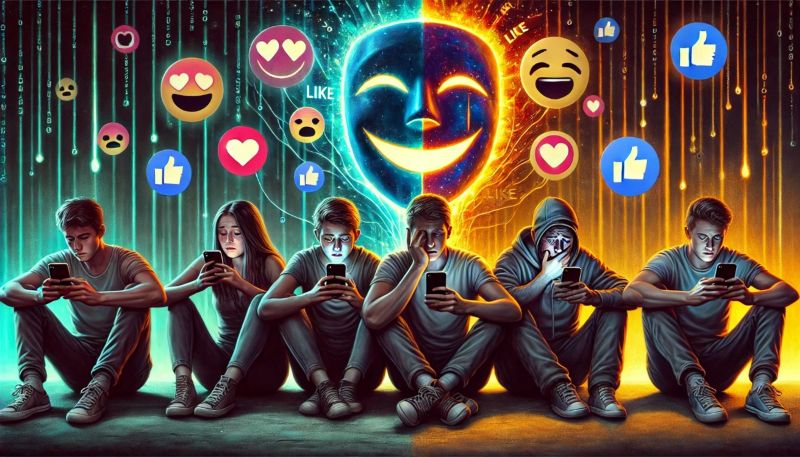
(Behind the screen, a smile - behind the smile, silent struggles.)
Get the most out of your digital tools by keeping a healthy balance
Setting up a healthy digital balance is important to overcome the harmful digital impact on mental health. Strategies include social media time limits, offline activities, and in-person connections with peers. Mindfulness practices from yoga to breathing exercises can also mitigate emotional responses to online content among young adults.
-
A Case Study Navigation of Social Media and Teens
-
Social Media Statistics and Their Impact on Teens
-
95% of teens aged between 13 to 17 years old use social media.
-
35 percent are using it “almost constantly.”
-
Juveniles using social media for more than three hours a day are at double risk for mental health problems.
How Can Social Media Be Both a Help and a Harm?
Social media can have a negative or positive impact on individuals, and young users especially. It can be a source of support, motivation, following and inspiration, but also brings risks of cyberbullying and anxiety. Here are two real-life examples that show each end of social media:
-
Case Study A:
- A 15-year-old girl faced serious online bullying. But she found a caring community on Instagram.
-
The clarity of teens on social media speech in her posts resonated with many, offering solace and strength.
-
Her involvement in teen social media ASL initiatives showed how strong inclusive communication can be.
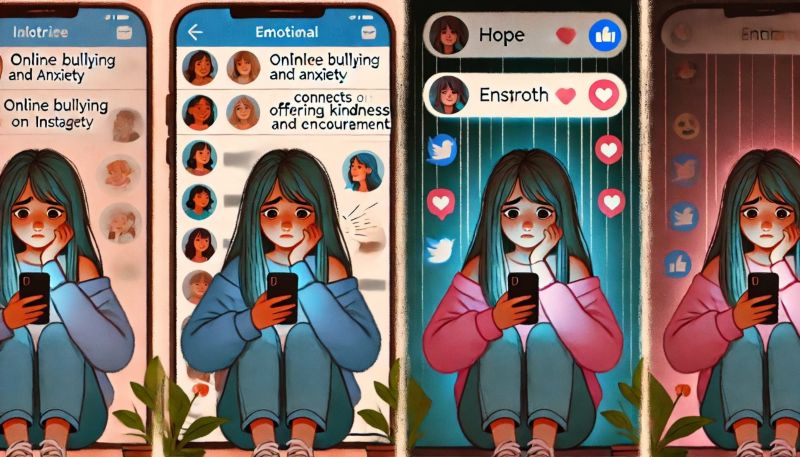
(Social media isolates and harms, yet it also heals and connects.)
-
Case Study B:
- A group of friends uses Snapchat to share daily affirmations, boosting their self-esteem and unity.
-
This creative use of ASL on teens on social media in their video messages fostered an environment of mutual support.
-
Their frequent use of social media as teens helped them build a solid support network.
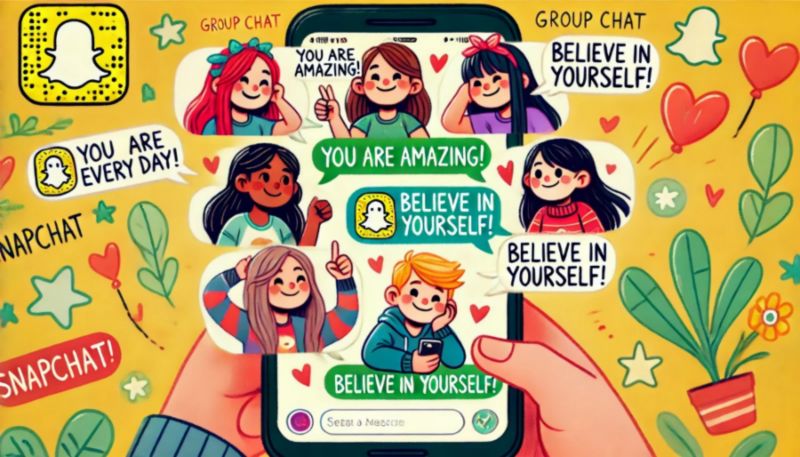
(Social media uplifts when used for positivity.)
Avoiding the Negative Effects of Social Media
This is particularly relevant as social media is becoming more ingrained in daily lives of young people. Parents, educators, & caregivers - who are helping to navigate a new generation of young users through these platforms safely , can also play a critical role. We can take these functions and ensure our mental wellness by creating such an environment where we can establish effective dynamics and restore social media usage to the wholesome text it was designed by.
Empowering Parents: A Guide to Digital Awareness and Online Safety
Parents are the first line of defense when guiding their children’s social media use. They need to know the benefits & risks of these digital platforms.
-
Learn Each App: Parents might need to educate themselves on popular social media platforms like Instagram, TikTok, Snapchat and Facebook. By knowing how these platforms work, parents will be best equipped to have informed conversations with their children.
-
Promote Conversations: Talk about online courtesy, privacy settings and the necessity of skepticism when consuming online information. Parents must also provide a safe space to talk about feelings and experiences related to social media.
-
Define Limits: Create explicit agreements about social media activity, like time spent online and what is permissible to share with others. For example, parents may only allow social media access in shared areas of the home where they can see how a child is using their device.
-
Implement Parental Controls: Most devices and apps have parental controls that can assist in blocking access to inappropriate material and limiting screen time. This is an opportunity for parents to use these tools to protect their children online.
-
Model Good Behavior: Kids don’t make choices in a vacuum. Parents can set a positive example by modeling healthy social media habits themselves - including limiting screen use and engaging in offline activities.
10 healthy social media habits for young people
-
Set Time Limits
Limit your social media time daily. It is well communicated on how sitting too long in front of a screen can have adverse effects on your physical and mental health, so setting limits on that can be a good way of not getting carried away. Helpful ways to manage this habit: screen time trackers, etc. -
Follow Positive Influencers
They also have access to the same social media accounts, so be sure to follow ones that inspire, educate or give you positive energy. There is a lot of research out there that says that surrounding yourself with positive content can help support your mental health! -
Take Breaks Regularly
The reason is that you need to make sure to detach from social media every now and then. Examples are taking breaks throughout the day to prevent digital burnout. Sitting through the work day can bring you down, but a 10-15 minute work break every couple of hours can work wonders. -
Be Mindful of What You Share
Always think before posting. Keep in mind that everything posted on social media often has a permanent record, even if deleted. If you do not post any personal information, please keep in mind your privacy and security. -
Engage Respectfully
Always be respectful and nice when talking to someone online. Stay away from derogatory remarks or flame wars, and treat others with empathy in online interactions with friends and even random personas. -
Limit Notifications
Minimize notifications that are not relevant to your work to prevent yourself from constantly being distracted. Notifications bloody your concentration and incentivize mindless screen time. Adjust your social media apps so you only receive important notifications. -
Do not Share Information Without Verification
Social media has proved a hotbed for misinformation. Now verify the facts and validate the source before you share any content. These are all protective measures to keep the Internet a healthier and safer place to be. -
Cultivate Offline Connections
Virtual interactions are great at keeping connections alive, but don’t neglect spending time growing bonds in the real world. Spend your time with a good mix of offline and online connections to make real friends. -
Practice Digital Detox
Once a week or month, attempt a digital detox - unplug from social media completely for a designated time. This will help reset your relationship with technology and give you time to invest in your interests and hobbies. -
Report Harmful Content
Report harmful or inappropriate content you encounter Social media networks are meant to have built-in processes to report objectionable discourse, and your action can help make the online world more hospitable for all.
Social Media Platforms and Young People: Good, Bad, or In Between?
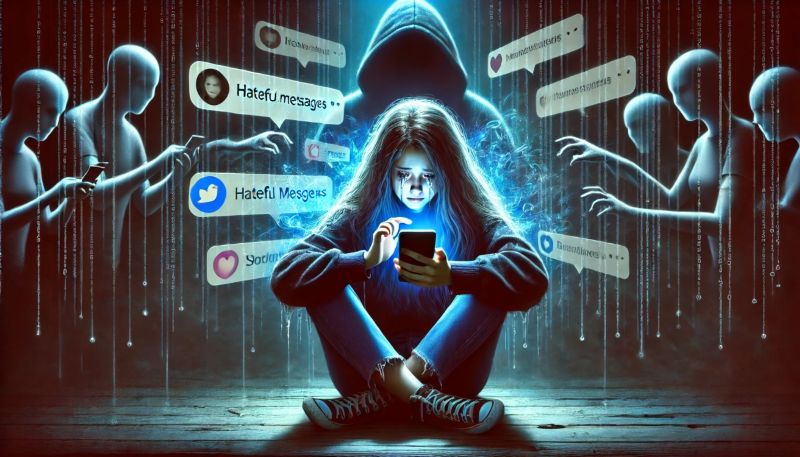
(Social media can connect or destroy - use it wisely.)
Key Ideas - Social media can facilitate connections, but its effects on youth are mixed, with significant risks to mental health and well-being.
Fostering Connections
-
Social media promotes self-expression, creativity, and community development.
-
It enables connections with others who share similar perspectives.
Mental Health Risks
Even though social media helps facilitate connections, it is also linked to:
-
Anxiety and depression.
-
Cyberbullying.
-
Unhealthy comparisons with others.
-
The pressures of online interactions, leading to self-esteem issues in youth.
A Guide to Social Media Use and how Parents Can Help
Parents hold the key when it comes to how their children interact with social media. By establishing rules and engaging in honest conversations, they can show kids how to successfully navigate the digital landscape. Here’s how parents can shape their child’s online experience:
- Online Behavior: Promote kindness, respect, and responsible online interactions. Acknowledge the fact that social media interaction can sometimes lead kids to post things without thinking, and encourage them to refrain from getting into negative exchanges online.
- Privacy settings: Help kids learn about and set privacy controls on their social media accounts. Discuss the dangers of disclosing personal information and the need to protect their profiles.
- Critical Thinking Skills: Help children question the credibility of what they see and read online, identify misinformation and avoid online scams. Teaching them to distinguish if what they’re reading is coming from a reliable source will encourage them to participate safely and intelligently.
Healthy Media Habits
To maintain a balanced digital lifestyle, youth should:
-
Manage screen time effectively.
-
Take social media breaks.
-
Consume positive and uplifting content.
Schools as Educators
-
Schools must take responsibility for teaching digital literacy.
-
Educating students on how to protect themselves and recognize the pros and cons of social media enables them to think critically and manage their digital footprints.
Involve All Stakeholders
-
Parents, educators, and policymakers must collaborate to find a balance between youth well-being and positive social media use.
Educate for the Digital World
-
Young people need proper training to navigate social media in a healthy and positive way.
-
As technology evolves and social media platforms change, it becomes harder to recalibrate how these platforms affect mental well-being.
Finding a Balance
-
To promote positive social media use, youth should be encouraged to engage in meaningful online activities while also maintaining offline relationships.
-
A well-rounded approach to digital well-being includes both online engagement and real-world interactions.
-
Social media is just one source of information - youth must be responsible, make informed decisions, and contribute positively to their communities.
Provide Support
-
A supportive environment strengthens youth resilience against social media’s negative effects.
-
Peer support systems allow students to share experiences and coping strategies.
Discussion Point
-
Ongoing conversations about social media’s impact are crucial.
-
Topics for discussion should include:
-
Emerging trends.
-
New challenges.
-
High engagement on social media.
Research and Policy Development
-
The continuous study of social media’s effects will help shape future policies.
-
A new policy framework is needed to:
-
Safeguard vulnerable young people from exploitation.
-
Promote responsible and positive online behavior.
Other Related Sections
NCERT Solutions | Sample Papers | CBSE SYLLABUS| Calculators | Converters | Stories For Kids | Poems for kids | Practice Worksheets | Formulas I Parent Resources
Related blogs:
Top 8 Apps You Can Use to Learn a New Language: Click and Learn more !
TV Shows And Movies You Can Watch With Your Child: Check out Exciting shows you might not know !
5 Best Animated Movies for Kids!: Perfect Good Movies.
Frequently Asked Questions
Social media is influencing youth behavior—an influence we don’t see as much in the past. It can affect self-esteem, decision-making, and communication skills.
Social media allows youth to interact with friends, consume educational material, express their creativity, and stay up to date with global events.
Overusing social media can result in cyberbullying, addiction, anxiety, depression, and a decrease in in-person socialization.
As social media offers also learning materials, but studies have shown that excessive use causes distraction, loss of focus and production levels in studies.
Parents can establish screen time boundaries, promote open conversations, supervise online activity, and teach about safe usage of social media.

